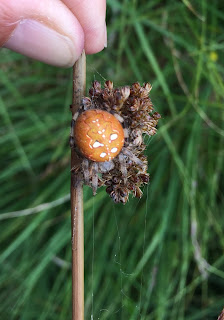 |
Moss-covered rocks on IoM
Image: K. Imms |
Here's Jon Shanklin's latest report from this year's BSBI Summer Meeting on the Isle of Man:
"Our fourth day without any rain, but it
won't last. Today was another coach tour, with first stop some mining
deads (local name for spoil heaps associated with former zinc or lead
mines).
"We nearly didn't go, as they were predicted to be scorched by the
sun, however almost as soon as we were out of the coach, first Ophioglossum
vulgatum was spotted then Botrychium lunaria.
"Entering the mining area
the recorder decided to avoid crossing any tetrad boundaries, which put some of
the area out of bounds although some participants just wandered around
looking at plants.
"A small stream was still flowing with water and
produced a verdant green channel, with some flushes, one of which had Drosera
rotundifolia.
 |
Botrychium lunaria
Image: K Imms |
"Walking back along the track we encountered a large green
caterpillar of an emperor hawkmoth.
"Our second stop was Glen Maye, and despite
a firm instruction of no lunch until 12:30, some convenient, although very
dilapidated, picnic benches proved too enticing.
"As lunch was concluding
we discovered that one of the party had gone missing so search parties ran
down the Glen in case he had already set off.
"After running for several
minutes there was no sign, so they had to run back up to the picnic
spot. Fell running wasn't an expected sport during the ASM!
"The
missing participant did eventually turn up, but by then the group had split
into the easy party who had a nice stroll down to the beach and the rough party
who strolled along the coastal path to Traie ny Volain. A subset decided
that descent of the cliff by an old smuggler path was a bit too rough
so explored along the top.
 |
Chris Preston & fellow bryologists
brave the weir in Silverdale
Glen in search of bryophytes
Image: A. Haden |
"The old smuggler path was blocked by brambles,
so we took a more or less bramble free alternative route that wasn't a path at
all.
"Safely at the bottom we checked several maritime species such as
Cochlearia officinalis, Tripleurospermum maritimum and Fumuria muralis. The last of course is not a maritime species, but was growing with them at the
base of a slip.
"The main point of the descent was however to see a cave where
there wonderful outgrowths of Adiantum capilllus-veneris.
"We then
had to ascend the cliff, which was rather more effort than the coming down, but
was safely accomplished, with an uneventful return to the coach.
"The evening talk was from Laura McCoy who
is curator of Natural History at the Manx Museum. She told us all about
the recent discovery of a skeleton of a Giant Deer on the northern coast
of the Isle of Man in a Characeous Marl.
 |
Eupatorium cannabinum
Image: J. Shanklin |
"Most likely it had been
exhausted after the rut, had wandered into a Chara-filled pond to stock up on
calcium and had become mired.
"After the talk it was time to return to our
homework in the maths lab, where we checked up on some of the difficult
specimens found during the day.
"The prettiest was a pavement weed found
by Ron, which nobody really recognised, though after a suggestion and a bit of
internet searching came out approximately as Nemesia denticulata.
"With rain forecast for tomorrow and no
indication of where might be driest we decided to stick with plan A and go to
The Curragh, split into four teams and see who could record the most (and see
the largest number of wallabies!)".




































